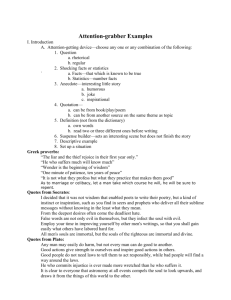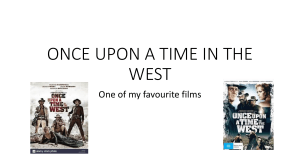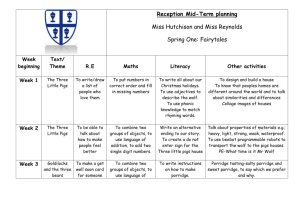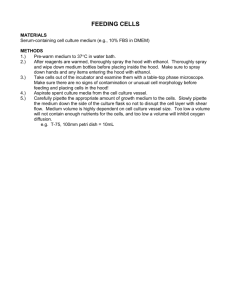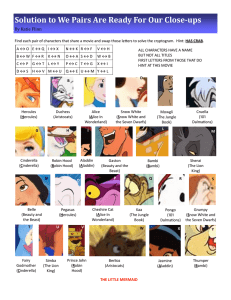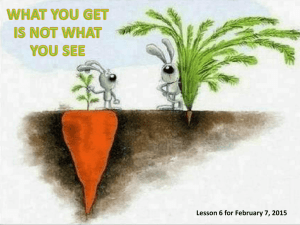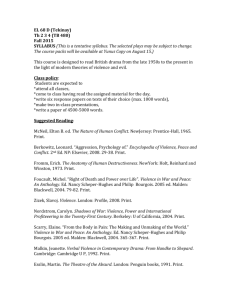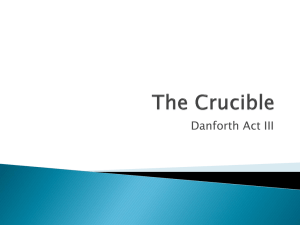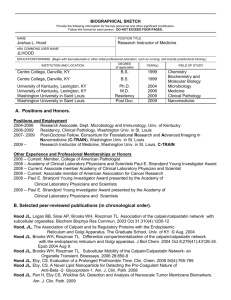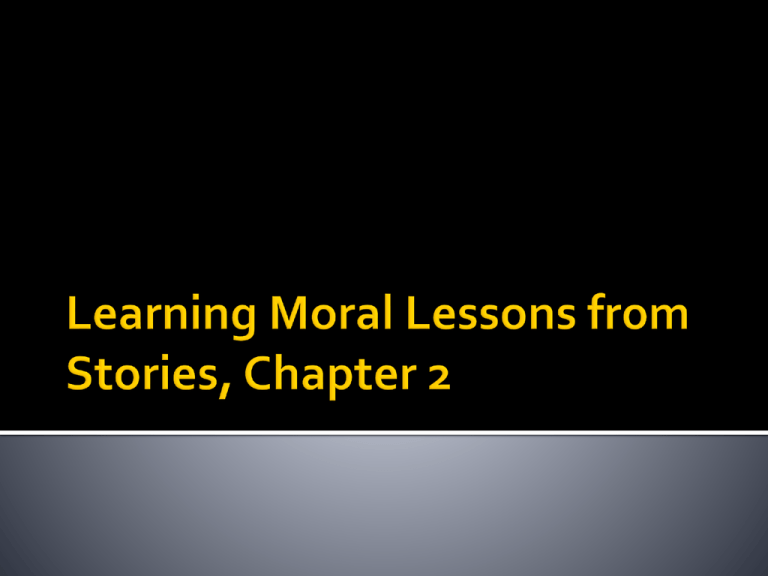
From our personal experiences
Caught doing something we weren’t supposed to
do or when we weren’t caught?
Rosenstand argues the most powerful lessons
we carry with us are lessons we learn from
the stories we have read or were read to us.
What are some of the important stories that you
read or were read to you as a child?
▪ Examples
The little boy that cried Wolf
Cinderella
Three little pigs
The little train that could
Even a blind squirrel will get an acorn once in awhile.
An idle mind is the devil’s workshop
Early to bed, early to rise makes a person healthy, wealthy and wise.
The early bird gets the worm
Birds of feathers flock together
A fool and his money is soon parted
Worthless as tits on a boar
Fools rush in where angels fear to tread
It is easy for someone who has never faced adversity to be brave
You can’t make an omelet without breaking some eggs
Let sleeping dogs lie
They’re all hat and no saddle
Even a stopped clock is right twice a day
Inter-generation transmission of values,
beliefs, wisdom
Lessons about morals and ethics
Understanding the difference between
intelligence and wisdom
Lessons across generations and time
Bibliotherapy—reading stories to children to facilitate
communication, explore difficult topics, emotions
Criminal justice intervention/prevention—learning through
watching mistakes of others
Psychotherapy—use of stories to help people think through
their situations
Cross-cultural or multicultural understanding
Philosophy—stories to explain difficult theories, explore the
richness in literature and films
Why are stories relevant for moral
philosophy? All cultures have narratives, and
often facts are combined with fiction in the
story.
What is the narrative of American Culture?
Often narrative are passed down through oral
traditions. But also through art, music and
literature. Oral vs literate culture
So what are the major themes of American
culture?
…All I really Need to Know about how to live
and what to do and how to be I learned in
kindergarten. Wisdom was not at the top of the
graduate school mountain but there in the
sandpile at Sunday school. These are the things
I learned…page 4.
Share everything.
Play fair.
Don’t hit people.
Put things back where you found them.
Clean up your own mess.
Don’t take things that aren’t yours.
Say you’re sorry when you hurt somebody.
Wash your hands before you eat.
Flush
Warm cookies and cold milk are good for you.
Live a balance life—learn some and think
some and draw and paint and sing and dance
and play and work every day some.
Take a nap every afternoon
When you go out into the world, watch for
the traffic, hold hands and stick together
Beware of wonder
LOOK.
Feel good
Group bonding
Stories knit the group together by illustrating
rules and boundaries that define the group
Stories pass on legacies, identities and values
Stories are often intertwined in religious
teaching, the creation story, birth of
important leaders, miracles performed, etc.
Stories that are historically true
Stories that never took place but have a special truth to
them—a poetic truth example Little Red Riding Hood.
Lesson—Don’t talk to strangers, beware of wolves
Interest in stories and the lives of public figures…what
accounts for this?
Princess Diana
Elvis
Titanic
Bill Clinton’s personal life
Myths- Never actually occurred but serve to remind us of
proper conduct/behavior
Fairy tales
Source of lessons
▪ Little Red Riding Hood, Hansel and Gretel, Cinderella, Snow White and the
Seven Dwarfs
Parables—an allegory story for adults; it is supposed to
understood as a story about ourselves and what we ought to
do.
Good Samaritan, prodigal son,
Abraham and Isaac
Fictional characters—sometime they’re role models—display qualities we can
identify with or would like to emulate—Superman, Batman, Robin Hood, John
Wayne, Harry Potter
Visualization—even in pre-literate cultures—murals or stained glass told stories
or displayed role models.
Archetypes – stories that return over and over
Bargain—someone bargaining with fate
The Good Twin and the Bad Twin
▪ Two personalities
▪ Or Two people who are closely related but are quite different
The Quest
▪ Moby Dick or Jaws, DaVinci Code, Raiders of the Lost Ark
Wartime Stories- (question of duty)
How young men were initiated into manhood through armed
conflict
The Longest Day, Bridge too Far, Saving Private Ryan, Black Hawk Down
Westerns (Deals with hard choices)
1865-1885
Evolution of westerns—interesting patterns of lessons or themes
Science Fiction: What future do we want? (desirable vs undesirable
futures)
Two types
▪ End of civilization
▪ Good times are emerging…
Mystery and Crime: The Fight Against Evil (questions of good and evil,
and what do with evil)
Ancient stories often dealt with tragedies—family passions, speculations on
the nature of fate, blood shed, violence
Modern day version—video games and television—violence, sex, drugs,
language,
Does viewing these videos incite some to become deviants?
1.
Plato—believed in censorship—he didn’t trust people to know what was
good or bad
2. Aristotle saw benefits to overall mind for to experience tension,
emotions, etc associated with violence
Whether one agree with Plato or Aristotle, the important point is that stories
affect us, and often differently
Why is it important to you?
What was the central message of the movie?
What ethical lessons were embedded in the
movie?
Using stories, video clips, music, and other
resources to highlight, supplement or provide
understanding of the readings.
A picture is worth a thousand words
Relevance
Interest
What are the key points….

